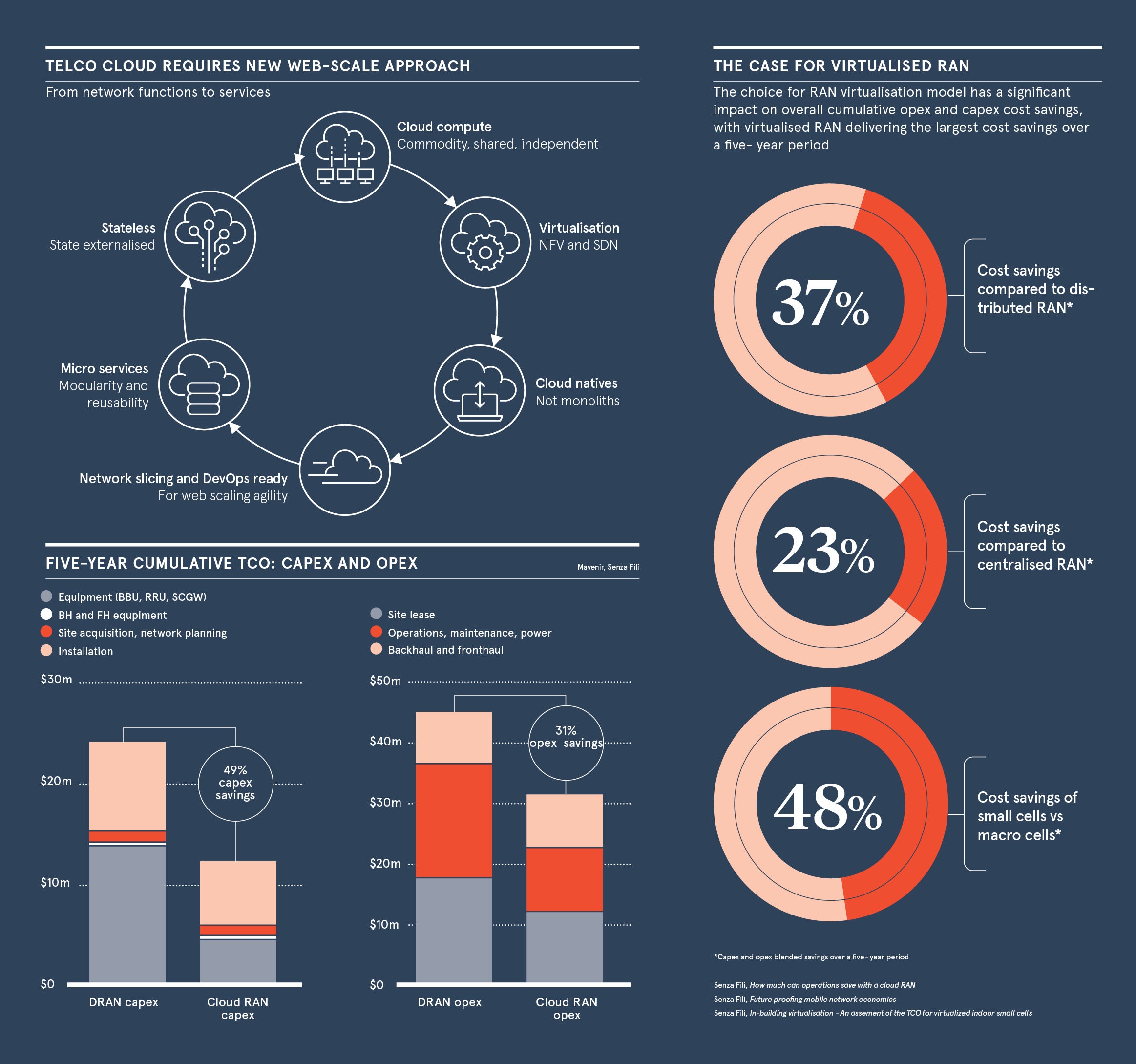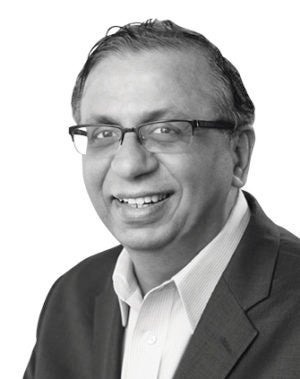The arrival of 5G, which will vastly accelerate mobile broadband speeds, is fast approaching. Mobile data traffic is expected to increase sevenfold between 2017 and 2022, while the number of internet of things (IoT)-connected devices will grow from around 8.4 billion today to forecasts of 20.4 billion by 2020.
Two thirds of global firms plan to harness 5G by 2020 to support their heavier data usage and IoT goals.
5G will only accelerate the volume and variety of data traffic further, shattering legacy service delivery models and impacting the network economics. For consumers, this is a welcome addition as they want and need more data.
For mobile operators, they face the technical test of squeezing vastly more data into a much faster and more efficient, yet less expensive, pipe. Transitioning to the 5G network requires significant investment in new infrastructures wit new capabilities, such as edge computing to be closer to the users and network slicing to effectively and efficiently utilise resources. 5G means higher bandwidth, lower latency and more capacity, but getting there will need a considerable increase in capital expenditure than carriers currently spend.
In a challenging business landscape, these economics are not likely to be viable for operators, particularly when current levels of capital expenditure are already constraining profitability and holding operators back from participating in new service revenues. GSMA, the global trade body for mobile network operators, forecasts their investments will decrease to $673 billion in the four years up to 2020 from $772 billion in the four years prior. This means they’re being forced to build new networks with the same or even less money.
Mavenir is redefining mobile network economics and is poised to disrupt the traditional equipment providers as a result, while helping operators succeed and deliver value in the 5G age
The network economics clearly need to change. To solve the problem, many operators are turning to alternative architectures that drastically reduce the costs of deploying 5G. At the heart of this shift is software-based technology and end-to-end virtualisation. This will open the door to new, automated, faster-to-deploy and less-expensive technology options, and allow them to move away from the traditional, telecom equipment providers and escape vendor lock-in.
In today’s mobile networks, the core was the first to be virtualised and enable cost-savings, but the more expensive layer, the radio access network, is still using traditional proprietary technology. Good news for the operators, vRAN (virtualised radio access network) is now a reality and will also generate opportunities to be more flexible at a lower cost. There is no 5G without end-to-end virtualisation because new capabilities like network-slicing are simply not possible.
Through an end-to-end, cloud-native solution, the virtualisation technology allows mobile operators to utilise commodity hardware and only deploy software. Meanwhile, the addition of open interfaces is enabling a more powerful ecosystem and allowing new innovative vendors to offer radio units at much lower prices. Open interfaces and virtualisation also mean operators can finally take control over their infrastructure and their economics.
The densification required by 5G and the ultra-low-latency requirements will make virtualisation even more important, along with micro services and service-based architecture. 5G architecture will need processing to be distributed and for capabilities to be deployed close to users at the edge.
The shift to containerisation is fundamental in evolving from virtualisation to network function virtualisation (NFV) infrastructure and finally to web-scale agility, enabling major differentiation in the market, as well as lowering operational costs through automation and orchestration. The migration towards NFV signifies a recognition among operators that their legacy business models are not sustainable. They need to change their cost-per-bit assumptions and revenue-generation capabilities.
Mavenir has virtualised core network and RAN functions on open-interfaces and standard hardware platforms to bring solutions to the market that meet the 5G standard and provide real options for operators.
The company is embracing mobile edge computing to enable the ability to scale in the 5G era, and provides all the capabilities at the same cost as operators currently pay. This means they can avoid the legacy pricing traditional equipment providers try to protect and instead utilise a more transparent licence system. As an end-to-end network software provider, Mavenir integrates the whole components, guaranteeing the solution works and performs as it should.
Mavenir has developed a total cost of ownership model which demonstrates that vRANs will save operators 37 per cent in deployment and operational costs over a five-year period, which consists of a 49 per cent reduction in capital expenditure and a 31 per cent drop in operational expenditure, according to Senza Fili.
For the core and in future scenarios of densification for radio, the savings can actually be much more substantial by decreasing capital expenditure by up to three times. These savings will allow mobile operators to not only embrace the 5G network, but to turn it into an engine of growth for their business, while still leveraging the 4G network.
As the cost of keeping up with traffic demand outpaces service revenue growth, the quest for new network economics is more urgent than ever. Operators have been boxed in by their traditional suppliers, and have not been able to leverage new and innovative technology advancements. The time has come to balance the needs of their current operations with the absolute necessity of embracing technologies that allow them to adopt new operational and business models.
With software assets that are natively designed for cloud environments, Mavenir is the leader of a new breed of independent network software suppliers that is delivering the innovation, agility and cost-savings mobile operators need to survive. By delivering end-to-end virtualised solutions from the core to the edge, Mavenir is redefining mobile network economics and is poised to disrupt the traditional equipment providers as a result, while helping operators succeed and deliver value in the 5G age.
For more information please visit mavenir.com
Q&A: How 5G will transform the way we live and do business
Pardeep Kohli, chief executive of Mavenir, explores how 5G will benefit enterprises, consumers and wider society, but only if organisations embrace new approaches to mobile networks
A lot of people are talking about 5G, but awareness of its capabilities is lacking. What benefits will we see?
With the ubiquity of smart devices and the explosive demand for data and bandwidth creating networks that are increasingly dense and complex, 5G can’t come soon enough. Through its unprecedented speed, capacity and latency, 5G will provide systems that are more responsive than ever. The new era will prove transformational in numerous areas of business and society, enabling compelling new services built on open software and hardware platforms operating in fully virtualised environments. This all comes with simpler and more flexible architecture that allows distribution to the edge, where processing is required in many cases. Service-based architecture introduced by 5G will also provide simpler and more business-oriented interfaces, ending the days of having to integrate complex protocols. The transition to 5G is as urgent as it is exciting.
What will 5G mean for consumers and how will it improve their lives?
There will be vast performance improvements for consumers to enjoy, with greater speed enabling more powerful browsing and gaming experiences. By providing extra capacity, 5G will increase average network speeds from 5 megabits per second to 20Mbps with peaks of 500Mbps. This will create the opportunity to bring more cloud services into the home, addressing security concerns and allowing people to live smarter by accelerating the internet of things (IoT) and bringing many new connected objects to life in quite transformational ways. The additional speed and capacity will also realise the full potential of smart cities. Citizens will experience less traffic, better parking facilities and more efficient utilities’ consumption, for example, as a result of more intelligent applications of smart technology.
Without virtualisation, there is no 5G; it is as simple as that. MNOs will have to embrace new approaches and Mavenir is here to help
How will businesses benefit from 5G?
There is huge value to be added for enterprises with the introduction of 5G. The entire infrastructure acts as a cohesive platform for innovative applications and is tuned to flex with demand, providing services tailored to their unique characteristics. Businesses are increasingly eager to explore applications, business models and efficiencies in the areas of automation and IoT, but the sheer volume of data means they lack the ability and low latency to respond fast enough to their processes and control systems. Local network capabilities were never distributed before, but this will change with 5G. By providing an enhanced ability to support exponential scale for connectivity, 5G opens the door for businesses to innovative applications across a variety of industries, including healthcare, with 5G allowing remote surgeries among other things, and automotive, enabling self-driving, and better diagnosis and maintenance.
Where exactly is the real value in 5G?
Automation, automation and automation again. 5G is coming and both consumers and businesses will enjoy greater capabilities than ever before. Gamers will be immersed in more responsive and interactive experiences, and technologies such as augmented reality and virtual reality will really come to the fore, not just for gaming applications, but for real-life benefits in areas like healthcare and education too.
What is holding us back from fully realising all these benefits?
The benefits of 5G are truly endless, but without new approaches to mobile networks through virtualisation and open interfaces, it will not be possible to disrupt the economic model and adopt web-scale agility and flexibility, which is key to its success. Mavenir, with its cloud-native, 100 per cent software, end-to-end solution, is providing that opportunity to operators and enterprises. Without virtualisation, there is no 5G; it’s as simple as that. We are here to help with the 5G paradigm shift and will transform the world of telecommunications by enabling companies to deploy it in an affordable way.


Q&A: How 5G will transform the way we live and do business




